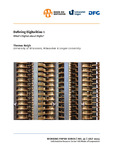Zitierlink:
http://dx.doi.org/10.25819/ubsi/10259Dateien zu dieser Ressource:
| Datei | Beschreibung | Größe | Format | |
|---|---|---|---|---|
| Haigh_Thomas_Defining_Digitalities_I.pdf | 6.23 MB | Adobe PDF |  Öffnen/Anzeigen |
| Dokumentart: | Book | Titel: | Defining digitalities I | Titelzusatz: | What’s digital about digits? | AutorInn(en): | Haigh, Thomas | Institut: | DFG-Sonderforschungsbereich 1187 "Medien der Kooperation" | Schlagwörter: | Digital, Analog, Binary, Differential analyzer, Bell Labs | DDC-Sachgruppe: | 302.23 Medien (Kommunikationsmittel), Medienwissenschaft | GHBS-Notation: | KNZT | Erscheinungsjahr: | 2023 | Publikationsjahr: | 2023 | Serie: | Working paper series / SFB 1187 Medien der Kooperation | Zusammenfassung: | Modern discourses emphasizes electronic immateriality as the defining feature of digital technology. The idea that digits might be digital when punched onto cards, or even written on a piece of pa- per, is no longer intuitive. Yet by reconstructing the context in which the categories of digital and analog were first distinguished histori- cally in the 1940s, I argue that the concept of digitality is rooted in the mechanical representation of digits in early computers, which con- temporary observers immediately recognized was shared with earlier technologies such as telephone switching systems, punched cards, and calculating devices. Digitality is not a feature of an object itself, but of the way that object is read (whether by human or by machine) as encoding symbols chosen from a finite set. In conclusion, digitality is constituted through reading practices. |
DOI: | http://dx.doi.org/10.25819/ubsi/10259 | URN: | urn:nbn:de:hbz:467-24526 | URI: | https://dspace.ub.uni-siegen.de/handle/ubsi/2452 | Lizenz: | http://creativecommons.org/licenses/by-nc-nd/4.0/ |
| Enthalten in den Sammlungen: | Publikationen aus der Universität Siegen |
Diese Ressource ist urheberrechtlich geschützt. |
Seitenansichten
343
checked on 03.04.2025
Download(s)
152
checked on 03.04.2025
Google ScholarTM
Prüfe
Prüfe
Diese Ressource wurde unter folgender Copyright-Bestimmung veröffentlicht: Lizenz von Creative Commons


